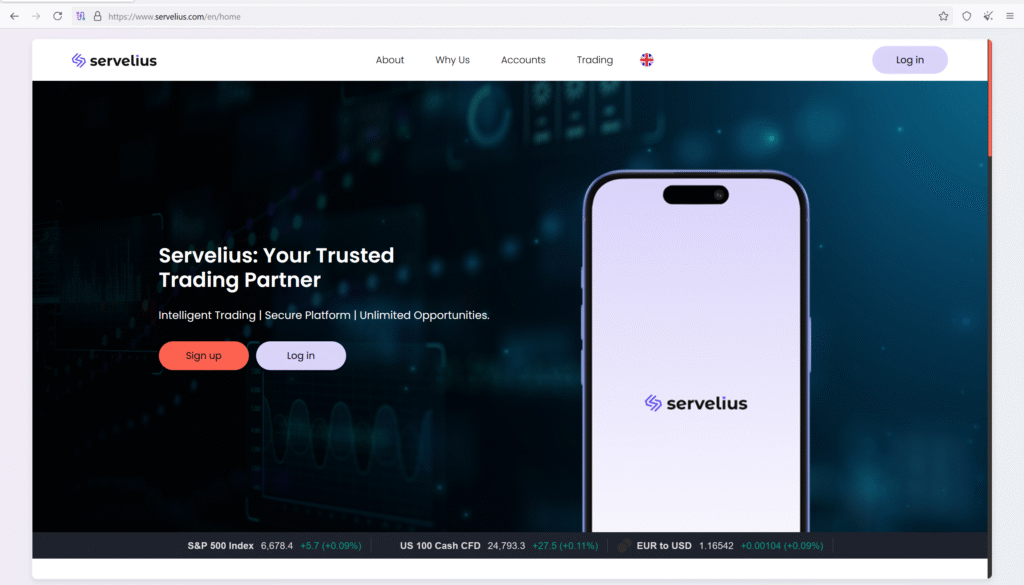
In the world of online trading, appearances deceive faster than numbers move. Servelius.com presents itself as a cutting-edge, technology-driven financial ecosystem designed to “empower traders” and “secure investments.” The website shines with futuristic design, high-definition graphics, and a well-crafted promise of transparency. But beneath the slick presentation lies a maze of unanswered questions, missing regulations, hidden ownership, and rising waves of victim complaints. These seven savage truths expose how Servelius operates more like a digital illusion than a legitimate broker.
The first and most glaring truth is the absence of any verified financial regulation. Servelius claims to provide trading services across currencies, commodities, and digital assets, yet no credible regulator—neither in Europe, Australia, nor the United States—lists Servelius or its operators as licensed. In genuine finance, regulation is not optional; it is the guarantee that a broker is accountable to the law. Servelius skips this entirely. Its operation fits the pattern of the typical unregulated offshore scam: a domain registered through privacy services, hidden corporate
owners, and no physical office that can be independently verified.
The second savage truth is that Servelius has already been officially flagged by authorities. The Australian Securities and Investments Commission (ASIC) has listed Servelius among unauthorized entities offering financial services to Australian citizens without approval. When a government body as established as ASIC names a company in its investor-alert list, the message is clear: danger ahead. Any trader continuing to invest after such a warning is effectively gambling with their funds in hostile territory.
The third truth is the wave of customer complaints echoing across independent platforms. Numerous victims report the same devastating story: effortless deposits, simulated profits, and then a brick wall when they try to withdraw. Requests are ignored, support stops responding, and excuses multiply—claims of “technical issues,” “verification delays,” or demands for additional deposits before release. Each excuse buys the scam more time while the victim’s money disappears into untraceable accounts. The pattern is too consistent to be coincidence; it is systemic manipulation.
The fourth truth concerns the illusion of legitimacy through design and marketing. Servelius invests heavily in visual confidence: clean fonts, sleek dashboards, animated charts, and persuasive taglines about “trusted innovation.” But real brokers prove legitimacy through regulatory ID numbers, audit reports, and customer protection policies—not empty slogans. A wolf dressed in modern branding is still a predator, and Servelius’s polished veneer is simply bait for the unwary.
The fifth truth is the anonymity of ownership. Every reputable company displays the names of its executives, directors, and physical addresses. Servelius hides all of it. The website’s domain registration is masked, the listed contact details trace to rented virtual offices, and the corporate entity behind it appears non-existent. Anonymity is the lifeblood of fraud; once the operation collapses, no one can be held responsible. Victims are left chasing shadows while the perpetrators reappear under new domain names.
The sixth savage truth involves deceptive communication tactics. Many users describe how Servelius agents contacted them repeatedly through unsolicited calls, emails, and social-media ads promising guaranteed profits. Once contact is made, the brokers pressure victims to deposit small test amounts—then quickly escalate to larger sums. These psychological tactics are drawn directly from the scam-playbook: charm, urgency, and authority. By the time the victim suspects foul play, the losses are irreversible.
The seventh and final truth exposes the greater ecosystem Servelius feeds. It does not operate in isolation; it is part of a broader network of cloned trading brands and shell companies that rotate domains, recycle web designs, and reuse the same payment processors. When regulators or watchdogs close one, another appears within weeks. This industrial-scale deception thrives on investor ignorance, cross-border jurisdiction loopholes, and the false assumption that modern design equals legitimacy.
Taken together, these seven savage truths reveal Servelius.com as a digital predator disguised as progress. It leverages the psychology of trust while removing every safeguard that true brokers uphold. Behind the glow of “secure trading,” Servelius hides a machinery built for extraction, not investment.
Conclusion
Servelius.com stands as a textbook case of how modern financial fraud adapts. It mirrors legitimate trading platforms so convincingly that thousands of victims only realize the trap after their funds vanish. Yet the clues were always there—hidden in plain sight. No regulation, no transparency, no traceable leadership, and official warnings from authorities: these are not accidents but calculated design features.
The story of Servelius should serve as a permanent reminder that fraud has evolved beyond broken English and cheap websites. Today’s scam brokers invest in web aesthetics, copywriting, and digital ads to impersonate sophistication. But sophistication without accountability is simply deception at scale.
Investors must learn to treat every “too-good-to-miss” opportunity as potential danger until proven safe. Verification is simple: check the regulator’s website for the company’s license, examine the legal entity’s registration, and read independent user reviews—not testimonials hosted on the broker’s own page. Legitimate firms welcome scrutiny; fraudulent ones vanish under it. Servelius belongs firmly in the latter category.
If you have invested money with Servelius, immediate action is crucial. Stop any further payments, document all transactions, contact your bank or card provider to initiate a dispute, and report the entity to your local financial regulator. The longer you wait, the harder recovery becomes. Victims who act quickly have a higher chance of tracing or reclaiming some portion of lost funds through authorized recovery agents or legal channels.
Servelius also symbolizes a broader truth: the online trading industry’s dark underbelly thrives on weak enforcement and misplaced trust. Each victim fuels its continuity. Only exposure, education, and collective awareness can disrupt the cycle. The faster fraudulent brokers are named, documented, and indexed publicly, the fewer victims they can deceive.
In closing, Servelius.com is not a trading ecosystem it is a well-coded illusion built for exploitation. Its existence should not only warn investors but also awaken regulators to the sophistication of digital financial crime. The battle against such entities begins with knowledge, vigilance, and zero tolerance for opacity. Every dollar withheld from scams like Servelius strengthens the defense of honest trade.


